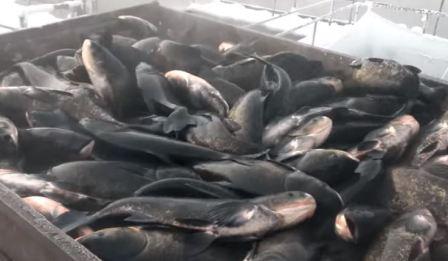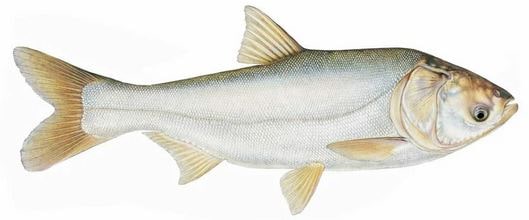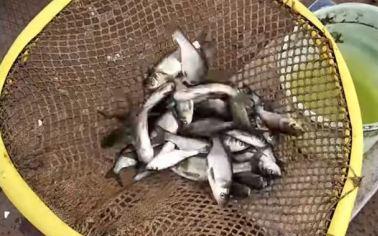Growing silver carp in aquaculture

Silver carp are often used for growing in ponds - silver carp and bighead carp. As a rule, growing silver carp at home is not difficult. In addition, breeding silver carp in a reservoir is important for water quality, because silver carp are good ameliorators that prevent algae in the water. Silver carp are bred in polyculture with other fish and other aquatic organisms. Silver carp are grown in rice fields, in cages, and in RAS. There is experience in growing silver carp in cages in desalinated sea bays. Growing silver carp is useful and profitable, which we will talk about in this article.
Content
- What does silver carp look like? Brief description
- Why are silver carp grown in a pond?
- Feeding silver carp in the pond
- Growth of silver carp in the pond
- Features of growing silver carp in a pond
- Recommended stocking density for silver carp
What does a white silver carp look like? Brief description

What does a silver carp look like? The silver carp is easily recognized by its laterally flattened body, which is covered with small scales. The age of a silver carp can be easily determined by its color - silver carp at the age of two to three years has a silvery color. What does a silver carp fish look like when it is 4 years old or more? It has a bluish-gray color. The upper part of the silver carp's back has a dark stripe on both sides, and the sides have a light tone. The eyes of the silver carp are located deep. The fish's mouth is directed upward, and its horizontal line stretches to the middle of the eyes. The silver carp has a keel that starts from the line of the gill opening and extends to the beginning of the anal fin. In its historical homeland in the Yangtze River, silver carp at the age of 12-15 years can reach a weight of 20 kg.
Why are silver carp grown in a pond?
Silver carp grows very quickly, especially in reservoirs of the southern regions. Silver carp is a good biological or pond promoter and can be grown in field culture, which increases the yield of marketable products and the profitability of the fish pond. In the southern regions of Russia and the CIS countries, with a good supply of food, silver carp grows faster than carp. Silver carp can be grown in reservoirs, lakes and other non-drainage bodies of water.
Growing silver carp in a pond allows you to dramatically increase the fish productivity of ponds, and at the same time raise waterfowl in the pond. By consuming phyto- and zooplankton, silver carp eliminate water blooms and protect ponds from death.
When silver carp are raised in cages, they tolerate cage conditions well. During storms, silver carp do not get motion sickness, nor are they depressed by a sharp change in the salt content in the water.
When growing silver carp in cages, there is no need to feed it. However, you should remember a small nuance when breeding silver carp in cages - small cells quickly become overgrown with aquatic vegetation, which reduces water exchange in the cages and, as a result, the supply of food. Therefore, it is necessary, if possible, to breed silver carp in cages with the largest possible cell size. This will allow the silver carp to grow faster and it will be necessary to wash the cage net less times to remove fouling.
It is profitable to breed silver carp in rice fields.
The breeding of silver carp fits perfectly into pond crop rotations, when after the cycle of growing fish in the pond, the water is drained and the bottom of the pond is used as a field for growing crops, and then the pond is filled with water again and the cycle of growing silver carp is repeated.
It is impossible not to note the benefits of breeding silver carp in a cooling pond, where silver carp grows and feeds well and improves water parameters.
Feeding silver carp in a pond
Nutrition for silver carp or what to feed silver carp in a pond. Every farmer who starts breeding silver carp in a pond will invariably have the question of what does a silver carp eat, what to feed a silver carp in a pond? The question is quite reasonable and it is necessary to consider the answer to it separately, what does silver carp eat.
Silver carp feeding type - silver carp feeds on microscopic algae - phytoplankton - in the pond, and also consumes detritus. Silver carp begins to feed in the spring when the water temperature reaches 9–10 ° C, with the onset of autumn, when the temperature drops to the same level, the silver carp stops feeding. In silver carp larvae, 8–9 mm long, the main food consists of rotifers; in fry that reach a length of 13–15 mm, lower crustaceans are the main food. When they reach a length of 15 mm, the juvenile silver carp switches entirely to feeding on planktonic algae. Therefore, adult silver carp is a phytoplanktophage. In spring and autumn, when there is little plankton, silver carp eats detritus. There is practically no competition in nutrition with carp and other fish species in polyculture. Silver carp grows well together with tench, carp, sterlet, silver carp and other fish. When silver carp and carp are reared together, a mutual positive influence of the fish on each other can be observed. Any measures to feeding or fertilizing, which is carried out for growing other fish, has a beneficial effect on the growth of silver carp. When growing silver carp in polyculture, you can get up to 5-6 quintals of marketable fish per 1 hectare without additional costs.
Growth of silver carp in a pond
How quickly does silver carp grow? The growth of silver carp is very fast, but the growth rate of silver carp is highly dependent on temperature and food supply. The further south the body of water, the greater the growth rate of silver carp. The optimal water temperature for the growth of silver carp at which it actively feeds is in the range of 26 - 30°C. If the water temperature drops to 10°C, the nutrition and growth of silver carp will decrease sharply.
How long does silver carp grow in central Russia? In central Russia, in ponds, young-of-the-year silver carp grow up to 7-10 g, how much does a two-year-old silver carp weigh - 400 g, and three-year-olds reach up to 800 g. Growing silver carp as an additional fish in carp ponds can significantly increase the productivity of ponds.
Silver carp growth chart, silver carp weight by year
Age Weight of silver carp by year g
1 year 7 - 10
2 year 400
3 year 800
Silver carp spawning
Silver carp age of maturity. Puberty in silver carp occurs at different ages and depends on climatic conditions. In the south of Central Asia, female silver carp mature at the age of three years; in the central regions of the country, maturation occurs only at the age of seven years.
A female silver carp weighing 7-10 kg produces up to 1 million eggs; the fertility of female silver carp is increased through selection to 1-2 million eggs. Embryonic development in natural conditions occurs during the drift of eggs in river water. The diameter of the unfertilized egg is 1-1.2 mm, after swelling it increases to 5 mm. Fertilized eggs are carried passively downstream. The swim bladder is filled with air at a temperature of 20-23 °C 80-85 hours after hatching. During this period, silver carp larvae switch to a mixed diet and begin to actively swim.
Features of growing silver carp in a pond

Silver carp, especially silver carp, are very sensitive to any damage. For this reason, silver carp should be transplanted from one reservoir to another as rarely and carefully as possible. Long-term transportation for silver carp is not the best option.
In many articles that are devoted to growing silver carp in a pond, it is advised to plant as much of the pond as possible with aquatic plants, citing the fact that in this case the silver carp will have a place to spawn. This advice is quite controversial; in the natural environment, silver carp spawn only in the Kuban and further south, but at the same time, it never spawns in ponds, even in ponds with strong flow. So there is no reason to plant the entire pond with aquatic vegetation for silver carp, unless grass carp will be raised in the pond together with silver carp, which will eat it. It is much more profitable to raise ducks in a pond, which will increase the food supply for silver carp.
As mentioned above, you shouldn’t count on silver carp spawning; you just need to purchase fish seeding material from specialized farms and grow silver carp to marketable size. There is no point in counting on artificial spawning of silver carp at home; this process is too complicated for a farmer without special education and equipment to carry it out.
It is also recommended to grow silver carp in ponds 3-4 meters deep; in nature, silver carp really love sections of the river with such depth, but silver carp grow well in shallower ponds. It is quite possible to plant yearlings of silver carp for cultivation in a pond at their summer cottage.
If possible, grow hybrid silver carp; it feeds on both phytoplankton and zooplankton, which ensures rapid growth and ensures that the fish do not starve.
You should carefully approach the process of stocking water bodies with silver carp. Stocking with silver carp is carried out in places with a depth of more than 1 m, which are free from aquatic vegetation and silt deposits, since the gill filaments of silver carp can very easily become clogged with silt.
Before planting silver carp, it is necessary to equalize the water temperature in the container and in the pond into which the fish will be released so that the difference in temperature does not exceed 2-3 °C.
Measures should be taken to combat silver carp diseases. Where such a disease as Pseudomonosis of silver carp is especially dangerous.
The presence of fish collection ditches outside the pond with good clean water makes it easier to catch silver carp.
The silver carp is very jumping, it jumps out of the water when there is noise. However, in cold water at a temperature of 4-5 ° C, when metabolism is greatly reduced, the jumping ability of silver carp decreases. Therefore, catching and transporting silver carp is carried out at low temperatures. The wintering of silver carp is the same as the wintering of grass carp.
Product indicators of silver carp
Silver carp is a valuable object of industrial fish farming.
Silver carp meat is highly a protein product in which the protein content is more than 15%. Silver carp meat is white because the meat does not contain myoglobin. The quality of silver carp meat proteins is characterized by the essential and non-essential amino acids it contains, the total amount of which reaches from 16.9 to 17.196 g/100g. In terms of fat content in meat (5.6%), silver carp is classified as a medium-fat fish (fat content 2-8%).
Interestingly, silver carp is the only freshwater fish that contains the same fat as sea fish.
Table - Linear-dimensional indicators of silver carp
|
Weight, g |
Total length, cm |
Carcass length, cm |
Height, cm |
Girth, cm |
|
245 |
27,5 |
16,5 |
9,7 |
20 |
|
312 |
31 |
18,5 |
8,5 |
21 |
|
325 |
30 |
14 |
8,5 |
21 |
|
354 |
35 |
19 |
9,7 |
21 |
|
365,1 |
31 |
15,5 |
8,5 |
20 |
|
762 |
38 |
30 |
11 |
24 |
|
963 |
45 |
35 |
12,5 |
26 |
|
2000 |
58 |
36 |
14 |
35 |
|
3150 |
62 |
39 |
18 |
37 |
|
5500 |
80 |
51 |
18 |
46 |
|
6050 |
82 |
51 |
19 |
48 |
Table Body weight and yield of the main parts of silver carp
|
Weight, g |
Carcass |
Little used products and waste |
||
|
weight, g |
yield, % |
weight, g |
yield, % |
|
|
245 |
155 |
63,3 |
90 |
36,7 |
|
312 |
175 |
56,1 |
137 |
43,9 |
|
325 |
170 |
52,3 |
155 |
47,7 |
|
354 |
185 |
52,2 |
169 |
47,7 |
|
365,1 |
205 |
56,1 |
160,1 |
43,8 |
|
762 |
427,5 |
56,1 |
334,5 |
43,9 |
|
963 |
531,2 |
55,2 |
431,8 |
44,8 |
|
975 |
565,5 |
58 |
409,5 |
42 |
|
3150 |
2105 |
66,8 |
1045 |
33,2 |
|
5500 |
3900 |
70,9 |
1600 |
39,1 |
|
6050 |
4000 |
66,1 |
2050 |
33,9 |
Recommended stocking density for silver carp
The stocking density of silver carp in a pond depends on many factors - region, food supply, species composition of fish, etc., and is calculated individually in each case.
The approximate norms for planting replacement young herbivorous fish in ponds when growing breeding material are as follows: common silver carp 600-800 pieces/ha in the southern regions and 200-400 pieces/ha in the middle zone with a piece growth over the summer of at least 1.0 kg.
Table - Stocking density of silver carp
Silver carp stocking density
Planting density of silver carp fingerlings in winter maintenance ponds, thousand pcs/ha 200-300
Planting density of silver carp breeders in winter ponds for all age groups, pcs/ha 1000
Stocking density of replacement silver carp stock in winter ponds for all age groups, except fingerlings, t/ha 10-20